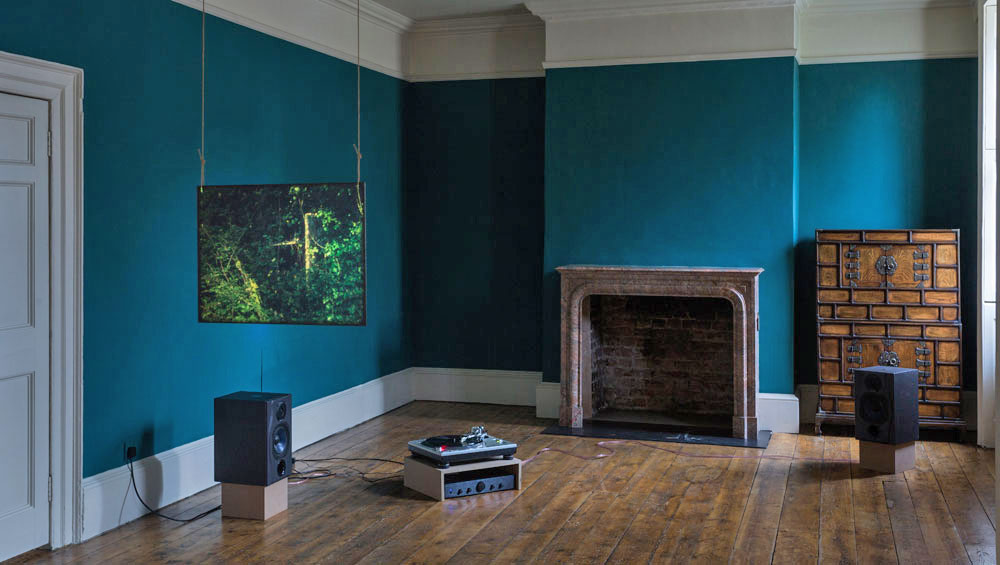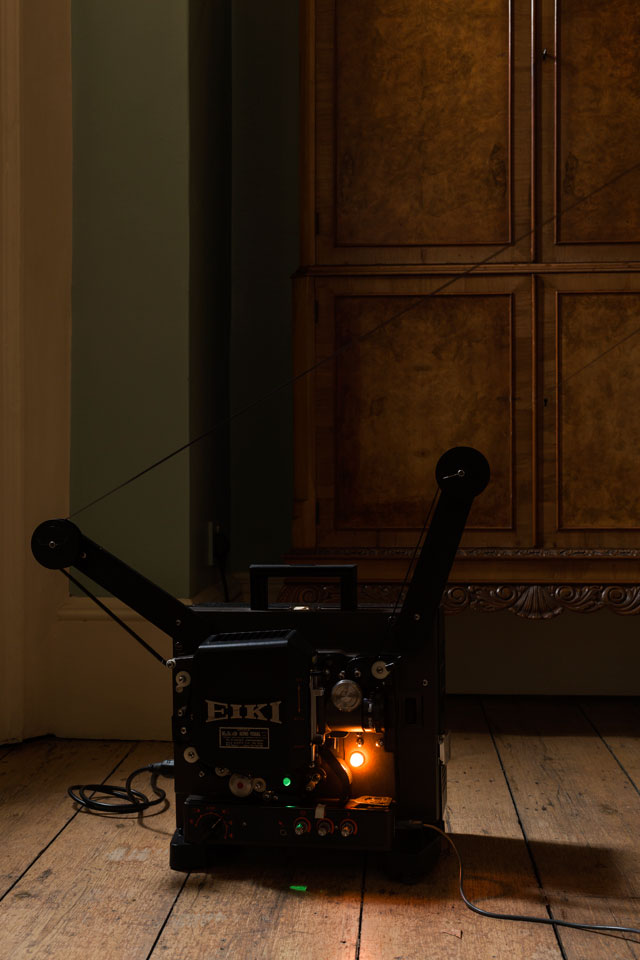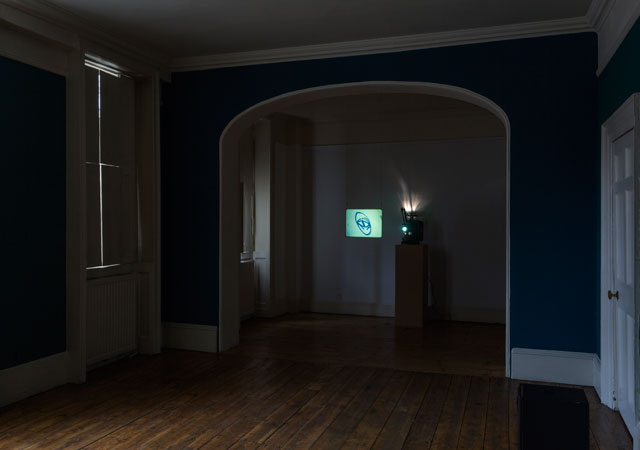
Danielle Arnaud, London
18 November – 9 December 2017
by HENRY BROOME
An unnerving whir fills the Danielle Arnaud gallery in London, the site of Louisa Fairclough’s exhibition A Song Cycle for the Ruins of a Psychiatric Unit. It echoes in the entrance hall, rings around the stairwell and becomes increasingly deafening the nearer visitors draw to the threshold of the ground-floor gallery where FEAR LIFE DEATH HOPE (2017) is displayed. The installation is based on a drawing by the artist’s deceased sister, which is in turn interpreted from a Gilbert & George work (Death Hope Life Fear, 1984) that pictures a hellish scene, featuring the duo rising (or perhaps falling – it is unclear) through row upon row of fiery-coloured flowers.
.jpg)
Louisa Fairclough. FEAR LIFE DEATH HOPE, 2017. 4 x 16mm projectors, 4 x film loops with optical sound suspended from meat hooks. Installation view: A Song cycle for the Ruins of a Psychiatric Unit, Danielle Arnaud Gallery, 2017. Photograph: Oskar Proctor. Courtesy the artist and Danielle Arnaud.
Using her sister’s sketch as an abstracted musical score, Fairclough, composer Richard Glover and musician George McKenzie arranged and recorded a series of glissandi (slides in pitch) on the site of a derelict psychiatric hospital. Singer Samuel Middleton chanted the words “fear, life, death, hope” one after the other, with each word assigned a different starting pitch. As he sang, his voice was taped on a reel-to-reel recorder, while speakers played the recording back into the room, building sound, layer on layer. Fairclough produced four tape loops, which were subsequently transposed on to 16mm film. In the gallery, the four films are played simultaneously on four projectors and their speakers. Because the film was exposed with no image (blank, except for the sound) the projector emits little light and the room is shrouded in darkness. As the eyes adjust, visitors see reels of film racing from the projectors on the floor to what appear to be shiny meat hooks hanging from the ceiling, criss-crossing the room at great speed, conjuring the violence and chaos of mania.

Louisa Fairclough. FEAR LIFE DEATH HOPE, 2017. 4 x 16mm projectors, 4 x film loops with optical sound suspended from meat hooks. Installation view: A Song cycle for the Ruins of a Psychiatric Unit, Danielle Arnaud Gallery, 2017. Photograph: Oskar Proctor. Courtesy the artist and Danielle Arnaud.
The work is driven by a relentless cyclical motion: the rotating projector spools produce an incessant ticking, while Middleton’s voice rises and falls, slowly whirring like a winding air-raid siren. Because the singer was recorded in a room with a low hemicylindrical roof, his voice generates a piercing resonance, which is amplified by the speakers in the gallery. Visitors seek respite around the periphery of room, but the sound reverberates back off the walls with even greater intensity. Its potency is inescapable and unremitting. Just as one glissando reaches a climax, another begins to ascend, replicating the strain of persistent mental torture. It cannot be sustained. The film will continue to hurtle around the meat hooks until, like a frenzied mind, it wears out and snaps.

Louisa Fairclough, A Rose, 2017, 1 x 16mm film looped (colour, silent, 9 minutes) projected onto a suspended acrylic screen, 1 x performance for a field recording pressed onto dubplate vinyl (20 minutes). Installation view: A Song cycle for the Ruins of a Psychiatric Unit, Danielle Arnaud Gallery, 2017. Photograph by Oskar Proctor. Courtesy the artist and Danielle Arnaud.
In the upstairs gallery, A Rose (2017) depicts the mind in ruin, exhausted from the turmoil of psychological trauma. The installation comprises a 16mm film and a vinyl recording, again both made within the dilapidated remains of the psychiatric hospital. In the film, the camera drifts through a building; dead leaves gather on the floor and ivy pours in through the roof and windows, blocking out the light – symbols of psychical degradation. The viewer also sees various pieces of recording equipment. Off-screen, Middleton chanted a number of words that were taped and played back into the room, as with Fear Life Death Hope, creating a composite soundtrack, which in the gallery is played through speakers from a vinyl recording. Middleton produces a mellow melody. As the recordings of his voice merge, his words become more and more indeterminate, generating a disquieting feeling of slow dissociation.
.jpg)
Louisa Fairclough, A Rose, 2017, 1 x 16mm film looped (colour, silent, 9 minutes) projected onto a suspended acrylic screen, 1 x performance for a field recording pressed onto dubplate vinyl (20 minutes). Installation view: A Song cycle for the Ruins of a Psychiatric Unit, Danielle Arnaud Gallery, 2017. Photograph by Oskar Proctor. Courtesy the artist and Danielle Arnaud.
Amid reports of continued cuts in the UK government’s spending on mental health, A Song Cycle for the Ruins of a Psychiatric Unit serves as an apt metaphor to highlight dwindling NHS resources. Through the complex layers Fairclough constructs in her work, the exhibition also provides a powerful evocation of interiority and psychological trauma – vital at a time when empathy is so lacking in politics.